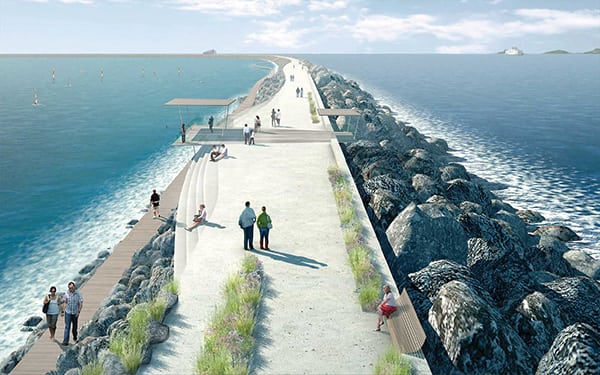UK Mulls Massive Tidal Lagoon Power Project
In the UK, which has the world’s largest offshore wind capacity, in large part due to government backing, formal negotiations have begun on public funding of a £1 billion ($1.48 billion) tidal lagoon project to produce electricity from turbines in Swansea Bay, South Wales.
The 320-MW project (Figure 3)—which could be the first of its type in the world when operational—would require building a breakwater to cordon off 4.4 square miles in Swansea Bay. The five-mile sea wall would be up to 20 meters high, though only half would be visible from land at low tide. Ultimately, it would funnel enough water to fill 100,000 Olympic swimming pools through dual-direction turbines, generating an estimated 420 GWh annually both at high and low tide. If built, the project could be online as early as 2018 and would last 120 years, its developer, Tidal Lagoon Power Co., says.
Wider plans call for four more projects, even larger than Swansea Bay, with an overall capacity of 7.3 GW. Tidal Lagoon Power in March sought government approval for a second site near Cardiff. The second lagoon could cover an area seven times larger than Swansea’s and have a capacity of between 1.8 GW and 2.8 GW.
For now, the Swansea Bay project seemingly has the blessing of some environmental groups because it could help the UK reduce its coal use. UK Energy and Climate Change Secretary Ed Davey backs it for the same reason, pushing it as a viable source of low-carbon power. Concerns about the project mostly hinge on its exorbitant costs—which aren’t settled and will depend on a range of factors. Experts say, meanwhile, that it could need a subsidy of£150/MWh ($222/MWh). The project’s developer says that Swansea is just a proof of concept, and that larger projects will produce cheaper power.
There are also permitting uncertainties, some warn, pointing to now-defunct plans to build the $45 billion Severn Barrage. The proposed 10-mile barrage linking the English and Welsh coasts was scrapped in 2013 for economic and environmental reasons.
—Sonal Patel, associate editor
